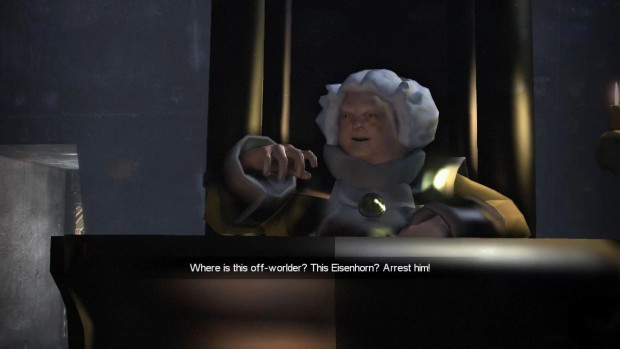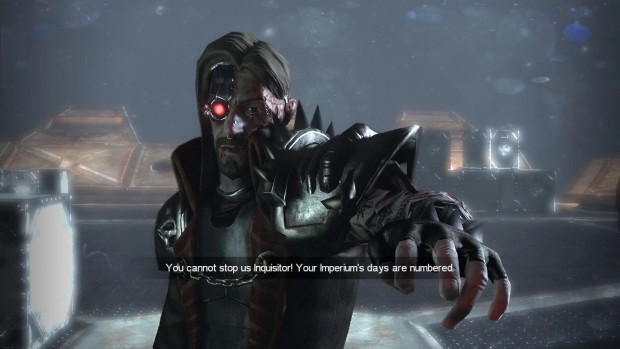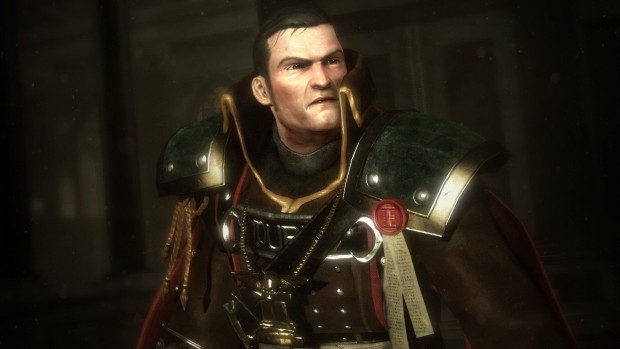While I have never actually played the Warhammer 40,000 tabletop game I did read the majority of the books, and out of all the various authors that took a crack at the grim darkness of the 41st millennium I consider Dan Abnett my favorite. From the very moment I picked up his Eisenhorn trilogy I knew I was in for a treat as he has a real knack for portraying sympathetic, flawed characters stuck in situations far beyond their grasp.
With that in mind, you can only begin to imagine how excited I was when I heard that Eisenhorn: Xenos, the first book in the series, would be getting the video game treatment. Not only is it an RPG set in the Warhammer 40,000 universe, something I've been waiting for decades now, but its also based on a story by one of my favorite authors! How could this possibly go wrong?
Unfortunately, the answer to that question is far lengthier than I could have ever anticipated. Pretty much every aspect of gameplay, from storytelling to combat, is suffering from a number of annoying issues, all of which combine together to create a thoroughly mediocre game. To make you understand what exactly is wrong with Eisenhorn: Xenos we need to go through all of its elements, one by one, starting with the most important factor - the story.
As you can probably guess given its origins, the writing and storytelling in Eisenhorn: Xenos is top notch as it slowly but surely reveals a compelling narrative full of interesting characters and unexpected twists. There are some areas where the story had to be shortened in order to fit the gameplay better, but overall I would say that this is a faithful adaptation of Abnett's story, at least as far as the big picture is concerned.
Best of all, the voice actor for Gregor Eisenhorn is equally as good and pretty damn close to what I imagined he would sound in real life. There is a certain air of cold authority in every line of dialogue, and even when he shows emotions they are mostly restrained, as they should be given his centuries-long carrier as an Imperial Inquisitor. With this strong of a start my hopes were riding sky-high for Eisenhorn: Xenos, but then I met the supporting cast and it all slowly started fading away.
While the voice actor behind Gregor Eisenhorn is fully capable of carrying himself as an Imperial Inquisitor, with all of the self-importance and limitless authority that position brings, nearly every single supporting character seems to have done their voice acting at gun point. I'm going to go out on a limb and say that the developers recorded it themselves in-studio, and while that would usually be OK, the difference in quality between them and Gregor is completely immersion-shattering given that their voices simply do not fit the characters, at all.

Betancore (left guy) is one of the coolest characters in the book, here... not so much
Another factor working in Eisenhorn: Xenos' favor is the presentation as it manages to nearly perfectly capture the grimdark feeling of the Warhammer 40,000 universe. Nearly every location you visit is impressive to look at due to its sheer scale and the amount of iconography celebrating the God Emperor, but also depressive due to the cold, metallic atmosphere that seems to permeate all of it. Its hard to explain these things to someone that might not be familiar with Warhammer 40,000 universe and its particular brand of architecture, but to put it simply, Eisenhorn: Xenos manages to make it work.
What doesn't work, however, are the character models. Outside of Gregor Eisenhorn and a couple of other key story figures, the majority of the characters seem to have a couple of defects or low resolution textures on their models, especially when they are in motion. These things might not sound important, but given how often Eisenhorn: Xenos likes to use cutscenes to deliver the story they become increasingly annoying with each repeat viewing.
The worst example of these graphical issues are the random shakes the characters experience when holding a conversation. Once again, this doesn't sound like a big deal, but when you have Eisenhorn's upper lip rhythmically twitching while his lower jaw hangs slightly open, things start to move quite quickly into the "uncanny valley" territory. This is a massive shame since some of the cinematics backed with Abnett's writing could have been truly emotional moments, but due to every single character being on their 15th cup of coffee its nearly impossible to take any of it seriously.

There's also moments where this happens
Continuing on with the architecture theme we have the level design, or shall I say the lack of there of. I personally enjoy RPGs that allow me a certain degree of freedom when it comes to solving quests, even though I'm fully aware this freedom is often completely artificial and that all paths eventually lead to the same outcome. However, the level design in Eisenhorn: Xenos doesn't even try to pretend you have a choice. It simply shoves you down a series of nearly identical corridors, constantly repeating the same two jumping and climbing animations, before moving on to the next cutscene or combat sequence.
I can understand how making complex levels can be a nearly impossible task for an indie studio, but the question is, why go through all of the effort in order to make something that's just completely bland. Why not instead take the adventure game approach and simply limit the amount of playable areas you can go to, but put all of the effort into making those locations as memorable as they can possibly be? As it stands, the only areas I can distinctly remember are the ones that contain some of the plot-relevant set-pieces as they have clearly had a lot love and care put into them, unlike the corridor #241 that leads on from there.

Such a lovely use of contrast!
To be fair, Eisenhorn: Xenos is not all about going down linear corridors in order to get to the next story bit, there are also some Final Fantasy XIII styled diversions where you can go slightly off the beaten path in order to find a couple of collectibles. These collectibles usually come either in the form of lore books which help further flesh out the story and add a bit more depth to the location you're in, or varying amounts of credits which you can then use to purchase new weapons... from yourself!
Silliness aside, this is a genuinely cool idea as RPG combat only remains interesting while you have new and exciting toys to look forward to, otherwise it all tends to become formulaic. To top it all off, the weapons are some of the most impressive pieces of Warhammer 40,000 technology. You've got bolters, chainswords, power swords, a variant of the always-awesome thunder hammer, plasma rifles, and so forth. It might not include all of the weapons you're familiar with from other Space Marine based games, but its still a solid assortment of weapons to play around with.

A thunder hammer? Yes please!
Unfortunately, there is almost no reason to purchase any of them as the combat is completely trivial. You can go through the entire game without even considering strategy for one moment, all you need to do is mash Mouse 1 like a crazy person and occasionally dodge ranged enemies when they finally decide its time to give the ol' gun a try. It also doesn't help that combat is by far the buggiest part of Eisenhorn: Xenos with enemies quite often getting stuck in the terrain, or worse yet, underneath the terrain which means you have to restart from the previous check point.
The list doesn't end there, however, as the combat animations and sound effects are far, far below the standard you might expect from any modern RPG these days. Hitting an enemy with a chainsword, a sword that constantly buzzes with ultra-sharp metal teeth, feels like tickling them given that there is almost no audio or visual feedback. For example, tearing your chainsword straight through someone (an attack that for some reason doesn't leave any impact on the enemy) produces a generic *THUNK* sound, as if you've just hit them with a baton and not the wrath of the God Emperor himself.

I was expecting a bit... more from a power sword
If mashing Mouse 1 against hordes of nearly identical enemies is not your thing, worry not as Eisenhorn: Xenos offers a stealth-based playstyle as well. Unfortunately, and I really do hate repeating this word, its equally as broken and devoid of challenge as the general combat. The AI is utterly brainless and will frequently miss you even if you're standing right in front of it, the guard patrol routes are too simplistic and easy to figure out, and worst of all, the guards don't seem to react to their friends suddenly being choke-slammed in the middle of the room.
What pains me the most isn't that the combat is bad, but rather that it could've been so damn amazing if the team had spent a few more months tweaking it to perfection. The fighting system could've used better animations and more responsive controls, while the stealth system would've been greatly improved through smarter AI and better level design. As it stands, the combat in Eisenhorn: Xenos is simply not fun.

Closing Thoughts
I am a massive fan of Warhammer 40,000, and an even bigger fan of RPG games in general, so believe me when I say that I really tried to make Eisenhorn: Xenos work, but it simply doesn't. Its not an unplayable mess I would only wish upon my enemies, far from that, but it is a different sort of extreme - a game so painfully generic there is almost nothing to be excited about unless you're the most die-hard of Warhammer fans. If you do decide to grab it, however, make sure you're doing so for the story as that is the one element of Eisenhorn: Xenos that I genuinely have no complaints about.
To end all of this on a positive note, I truly do believe that the Eisenhorn series has a real chance to become not just good, but downright amazing. All of the elements that make a great RPG are present here, but they are currently so underdeveloped they might as well not exist, but a sequel at some point in the future might just bring them to their rightful place. So while I can't in all honesty recommend you Eisenhorn: Xenos, I will suggest you keep an eye on the series as Eisenhorn: Malleus, should it ever come to fruition, might just be the RPG us Warhammer 40,000 fans have been waiting for.

